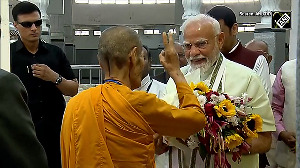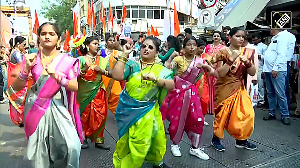India’s regional policy has fallen between the two stools of pragmatism and principle. It’s time India revisited and rectified its approach. Relations with neighbours deserve nothing less, says Praful Bidwai.
India’s neighbourhood is in great turmoil, but New Delhi seems unable to fashion a coherent, balanced, mature and self-confident response to it. In particular, India has dealt with Sri Lanka, Bangladesh, Maldives, Myanmar and Nepal in confused and indecisive, if not wholly inept, ways. This has eroded India’s influence and legitimacy in the 'Gujral Doctrine' countries, comprising South Asia without Pakistan, with whom India pledged to establish close relations by “going the extra mile” without demanding reciprocity.
Take Sri Lanka, where the Mahinda Rajapakse government, in a show of belligerent Sinhala chauvinism, has turned its face against the Tamil minority’s wholly legitimate demand for regional autonomy and devolution of power -- which India has supported and articulated for long years. Still gloating over its May 2009 victory in the war against the Liberation Tigers of Tamil Eelam, the Rajapakse regime is riding roughshod over human rights and press freedom.
It stands acutely embarrassed by photographs just released by Britain’s Channel 4 Television, which suggest that LTTE chief V Prabhakaran’s 12-year-old son Balachandran was killed in cold blood by the Sri Lankan military. Two photographs show the boy sitting in a bunker and eating a snack, seemingly in the custody of the security forces. The third one shows his dead body with unmistakable bullet wounds in the chest.
The disclosure will cause the Sri Lankan government great discomfiture when it comes up for a likely reprimand at the UN Human Rights Council. The government’s dismissal of the photographs as “lies, half-truths and speculations” calculated to corner it at the council just won’t wash. Channel 4 claims it has consulted experts who say the three pictures were taken with the same camera. It candidly admits that its motive in releasing them, and also a documentary film later, is to make the Sri Lanka government accountable for civilian deaths in the final weeks of the anti-LTTE war.
For more than three years, the Rajapakse government asserted parrot-like that there were “zero civilian casualties” in the war, which decisively defeated the LTTE. It has since begun to accept that some civilians did die, but claims they mostly died in crossfire. The number and circumstances of the killings are hotly disputed. But there’s no dispute that killing civilians is impermissible and illegal.
Independent investigations have established that thousands, probably well over 10,000, Tamil civilians were brutally killed in the war’s final phase, some of them with their hands tied at the back. The killings sharply increased after September 2008, when the United Nations was forced to quit the war zone and the Sri Lankan military jettisoned all rules of engagement and targeted civilians. This is impermissible even in war, and must be unequivocally condemned and punished.
The Balachandran photos prima facie show cold-blooded custodial murder, which is all the more revolting because he was a juvenile. It should be easy for the government to identify the chain of command involved in keeping the boy in a sandbagged bunker and killing him. It’s imperative that the culprits be tried and given exemplary punishment. That indeed was one of the objectives of the 'Lessons Learnt and Reconciliation Commission', which the Sri Lankan government set up at the HRC’s goading in 2012. But it’s dragging its feet on this.
On logical as well as ethical grounds, India should have taken a clear, unambiguous stand on civilian casualties, in particular on Balachandran’s killing. India was in no small measure responsible for President Rajapakse’s success in militarily annihilating the LTTE. The fourth Eeelam war beginning mid-2006 could not have been won without the Indian Navy’s logistical and radar support.
It was morally obligatory for India to have ensured Sri Lanka’s compliance with the Geneva Conventions and laws of war based on non-combatant immunity. But India didn’t deliver on this. It says the Balachandran photographs’ “authenticity” must be established first. This isn’t an adequate response. India must convincingly uphold, and be seen to uphold, justice in the conduct of war and take an uncompromising stand on civilian immunity.
The HRC is a good forum to do this. Instead of taking an independent position there, and also using the bilateral route, India is planning to vote against Sri Lanka with the United States in a “country-specific” resolution. Tailing the US doesn’t speak of foreign policy autonomy. And the sudden abandoning of a long-held stand against “country-specific” resolutions is inexplicable.
In fact, India’s Sri Lanka policy is determined by an awkward attempt to balance various contradictory influences and pressures: the domestic push for a tough stand vis-a-vis Colombo from ethnic Tamil parties, anxiety to neutralise growing Chinese influence in Sri Lanka fuelled by aid, military supplies and assistance towards building a port at Hambantota, and leveraging India’s status as Sri Lanka’s biggest investor and trading partner.
India-Lanka relations have a complicated, fractious past. In the early 1980s, India armed and trained the LTTE, a murderous force which committed countless atrocities against its real and imagined opponents. India soon turned against the Tigers and sent the Indian Peace-Keeping Force to Sri Lanka in 1987. The IPKF failed to disarm the LTTE and had to beat an ignominious retreat. Meanwhile, the devolution agenda remained unfulfilled, and Sinhala chauvinists came to power. India did little to temper their malign influence. Bilateral relations have remained messy.
Consider Bangladesh. India’s relations with it have improved over the past four years, with reduced trade barriers, better transit facilities, a $1 billion Indian line of credit, and more infrastructure investment. But there hasn’t been a breakthrough which would make the improvement irreversible.
India lost an invaluable opportunity to seal an agreement on the waters of River Teesta and a land boundary deal to swap 162 enclaves in each other’s territories. Prime Minister Manmohan Singh caved in to the temperamental Mamata Banerjee, who vetoed the Teesta agreement for petty reasons. Bangladesh has delivered on its part of the bargain by handing over more than 20 Assamese and Bodo separatist militants and cracking down on their camps. But India has betrayed its promise despite entreaties by Prime Minister Sheikh Hasina to take a “progressive view” of the Teesta issue.
Nobody expects India to lend overt support to the great mobilisation under way at Shahbag Square to demand stiff punishment to Jamaat-e-Islami leaders for their 1971 war crimes and other atrocities. But the least India can do is deliver on its pledges and not propose new projects on shared rivers in Meghalaya without prior consultation with Dhaka and its full consent at this delicate juncture.
Little Maldives is another site of Indian diplomacy’s ineptitude, first noted in 1988, when New Delhi gratuitously intervened militarily to prevent a coup against President Maumoon Abdul Gayoom. Last year, India again flexed its muscle by siding with the Indian company GMR, which faced a cancellation of its contract to build an airport. India threatened Maldives, but the threat didn’t work.
Earlier, in February, India had hastily described the ouster of President Mohammed Nasheed by Mohammed Waheed as legitimate, ignoring the coercion involved. India lost precious time in correcting course. Meanwhile, the US and China stepped into the vacuum. The US plans to build a military base in the Maldives, and China is pouring aid into the country to gain leverage.
Last fortnight, India again got embroiled in the Maldives’ politics by giving shelter to Nasheed and shielding him against a court’s arrest warrant. The crisis was temporarily resolved through a truce brokered not by the Indian ambassador, but a diplomatic team especially sent from Delhi. However, it’s not clear if India can use its influence to ensure free and fair elections in September in which Nasheed can participate, and generally to promote peace and normalcy in the country.
In Myanmar, India first rightly backed pro-democracy leader and long-standing friend Aung San Suu Kyi, but switched over to the ruling junta to counter growing Chinese clout in the country. Such “pragmatism” didn’t eventually help much. The regime recently opened up Myanmar’s economy and political process. In response, many countries relaxed sanctions on Myanmar.
Upon entering parliament, Suu Kyi visited Europe and the US before coming to India. When she came, she expressed her “disappointment with India”. Many countries have been quick to bid for Myanmar’s rich natural resources since it opened up. India, Myanmar’s fourth biggest trade partner, is not even Number 10 in the investors’ list. India still lacks a coherent Myanmar policy.
In Nepal, India helped reach a historic agreement between the Maoists and mainstream parties, which led to the deposing of the monarchy and free elections to a constituent assembly. But India quickly lost much of the goodwill thus earned by taking partisan political positions, while doing little to aid the formation of a broadly acceptable government or the writing of a constitution. India is losing credibility and influence in the mess that’s Nepal.
India’s regional policy has fallen between the two stools of pragmatism and principle. It’s time India revisited and rectified its approach. Relations with neighbours deserve nothing less.






 © 2025
© 2025